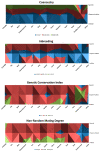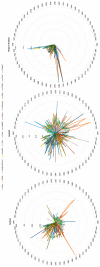One Hundred Years of Coat Colour Influences on Genetic Diversity in the Process of Development of a Composite Horse Breed
- PMID: 35202321
- PMCID: PMC8879117
- DOI: 10.3390/vetsci9020068
One Hundred Years of Coat Colour Influences on Genetic Diversity in the Process of Development of a Composite Horse Breed
Abstract
Genetic diversity and demographic parameters were computed to evaluate the historic effects of coat colour segregation in the process of configuration of the Hispano-Arabian horse (Há). Pedigree records from 207,100 individuals born between 1884 and 2019 were used. Although coat colour is not a determinant for the admission of Hispano-Arabian individuals as apt for breeding, it may provide a representative visual insight into the gene contribution of Spanish Purebred horses (PRE), given many of the dilution genes described in Há are not present in the Arabian Purebred breed (PRá). The lack of consideration of coat colour inheritance patterns by the entities in charge of individual registration and the dodging behaviour of breeders towards the historic banning policies, may have acted as a buffer for diversity loss (lower than 8%). Inbreeding levels ranged from 1.81% in smokey cream horses to 8.80 for white horses. Contextually, crossbred breeding may increase the likelihood for double dilute combinations to occur as denoted by the increased number of Há horses displaying Pearl coats (53 Há against 3 PRE and 0 PRá). Bans against certain coat colours and patterns may have prevented an appropriate registration of genealogical information from the 4th generation onwards for decades. This may have brought about the elongation of generation intervals. Breeder tastes may have returned to the formerly officially-recognised coat colours (Grey and Bay) and Chestnut/Sorrel. However, coat colour conditioning effects must be evaluated timely for relatively short specific periods, as these may describe cyclic patterns already described in owners' and breeders' tastes over the centuries.
Keywords: Arabian purebred horse; Spanish purebred horse; coat colour; composite breed; genetic diversity.
Conflict of interest statement
The authors declare no conflict of interest.
Figures








Similar articles
-
Discriminant Canonical Analysis of the Contribution of Spanish and Arabian Purebred Horses to the Genetic Diversity and Population Structure of Hispano-Arabian Horses.Animals (Basel). 2021 Jan 21;11(2):269. doi: 10.3390/ani11020269. Animals (Basel). 2021. PMID: 33494478 Free PMC article.
-
Explicit evidence for a missense mutation in exon 4 of SLC45A2 gene causing the pearl coat dilution in horses.Anim Genet. 2019 Jun;50(3):275-278. doi: 10.1111/age.12784. Epub 2019 Apr 10. Anim Genet. 2019. PMID: 30968968
-
Pedigree estimation of the (sub) population contribution to the total gene diversity: the horse coat colour case.Animal. 2010 Jun;4(6):867-75. doi: 10.1017/S1751731110000182. Animal. 2010. PMID: 22444259
-
Molecular tests for coat colours in horses.J Anim Breed Genet. 2009 Dec;126(6):415-24. doi: 10.1111/j.1439-0388.2009.00832.x. J Anim Breed Genet. 2009. PMID: 19912415 Review.
-
Genetic Diversity and Population Structure of Arabian Horse Populations Using Microsatellite Markers.J Equine Vet Sci. 2020 Oct;93:103200. doi: 10.1016/j.jevs.2020.103200. Epub 2020 Jul 31. J Equine Vet Sci. 2020. PMID: 32972687 Review.
Cited by
-
Modeling Climate Change Effects on Genetic Diversity of an Endangered Horse Breed Using Canonical Correlations.Animals (Basel). 2024 Feb 20;14(5):659. doi: 10.3390/ani14050659. Animals (Basel). 2024. PMID: 38473046 Free PMC article.
-
Unlocking Horse Y Chromosome Diversity.Genes (Basel). 2022 Dec 2;13(12):2272. doi: 10.3390/genes13122272. Genes (Basel). 2022. PMID: 36553539 Free PMC article. Review.
-
Pedigree-Based Description of Three Traditional Hungarian Horse Breeds.Animals (Basel). 2022 Aug 14;12(16):2071. doi: 10.3390/ani12162071. Animals (Basel). 2022. PMID: 36009663 Free PMC article.
References
-
- Neves A.P., Schwengber E.B., Albrecht F.F., Isola J.V., De Salles van der Linden L. Beyond fifty shades: The genetics of horse colors. In: Abubakar M., editor. Trends and Advances in Veterinary Genetics. IntechOpen; London, UK: 2017.
-
- Thiruvenkadan A.K., Kandasamy N., Panneerselvam S. Coat colour inheritance in horses. Livest. Sci. 2008;117:109–129. doi: 10.1016/j.livsci.2008.05.008. - DOI
-
- Sponenberg D.P., Bellone R. Equine Color Genetics. John Wiley & Sons; Hoboken, NJ, USA: 2017.
-
- Aguilera Pleguezuelo J. El Caballo Español e Hispano-árabe en la Historia y en los Manuscritos de Al-Ándalus. Almuzara; Córdoba, Spain: 2006.
LinkOut - more resources
Full Text Sources
Research Materials

